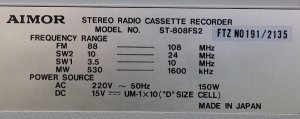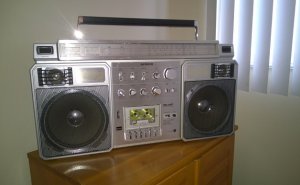Joe, I didn't know that. However, looking at the speakers, they physically appear identical. I would guess that there's no real difference between them and once again, probably just a labeling/rating requirement for reasons of compliance with local regulations. In order for one speaker to truly handle more power than another otherwise similar speaker, the voice coil windings would need to be wound with thicker gauge wire. This usually translates to more weight, and larger voice coil.blu_fuz said:M90JW and M90C do have a different wattage rating on the speakers though.
C wattage on the speaker is 25W:
IMG_5137.JPG
JW wattage on the speaker is 20W:
IMG_5138.JPG
RC-M90JW versus RC-M90C
- Thread starter Transistorized
- Start date
You are using an out of date browser. It may not display this or other websites correctly.
You should upgrade or use an alternative browser.
You should upgrade or use an alternative browser.
- Status
- Not open for further replies.
trippy1313
Member (SA)
Interesting, I should see what mine are.blu_fuz said:The 20 W and the 25 W speakers are physically identical in weight and size .
I've kind of been looking for a thread like this on the M90. I know there was one on the M70 models. I suppose we have enough here in the group to finally figure out what differences there actually are.
hopey
Member (SA)
What about the Frequency? As the model that has the multi tap transformer (240/220/110v) and can run on 50hz means it's an upgraded power supply this should give you a boost in Output therefore the same circuitry and speakers have been upgraded (although identical).
Frequency
Both 50Hz and 60Hz have their advantages and disadvantages.
60Hz
With 60Hz, the transformers can be smaller and less expensive than for a 50Hz transformer. Although the difference is small, it can add up in a system with many transformers. Using 60Hz results in less flicker on lamps, but that really is not a factor these days.
Hum and frequency noise are more readily audible with 60Hz and its harmonics than with 50Hz.
50Hz
With 50Hz, electric power transmission over long lines favors it over 60Hz. The effects of the distributed capacitance and inductance of the line are also less at the lower frequency.
Although 50Hz transformers require more copper and iron, 60Hz transformers require more expensive plates to prevent eddy current losses.
Frequency
Both 50Hz and 60Hz have their advantages and disadvantages.
60Hz
With 60Hz, the transformers can be smaller and less expensive than for a 50Hz transformer. Although the difference is small, it can add up in a system with many transformers. Using 60Hz results in less flicker on lamps, but that really is not a factor these days.
Hum and frequency noise are more readily audible with 60Hz and its harmonics than with 50Hz.
50Hz
With 50Hz, electric power transmission over long lines favors it over 60Hz. The effects of the distributed capacitance and inductance of the line are also less at the lower frequency.
Although 50Hz transformers require more copper and iron, 60Hz transformers require more expensive plates to prevent eddy current losses.
The discussion of 50 vs 60 hz really isn't useful here because we can't choose whether our locals use 50 or 60 hz, it is what it is, but insofar as the transformers on THIS boombox is concerned, to my knowledge, both the 61 and 70 watt rated versions spec 50/60 hz. So no difference. Even if a transformer were capable of handling more power before it overheats, the boombox must be capable of consuming higher current to be useful, and if the circuitry is the same, then the boombox's ability to consume higher current will be dictated by how much voltage it is fed. The higher the voltage, the more current can be consumed. If transformer x and transformer y both output 18v and both are capable of providing the min output necessary to power the boombox, AND but transformer y can handle more current, it STILL will make no difference because both x and y will output only what the boombox needs.
hopey
Member (SA)
I was a little off target. When you look at power ratings there are two values e.g. USA and Australia, the Australian version has a higher capacity due to the higher voltage and 50hz rating. When you have a multi tap transformer the lower voltage and frequency 110v/50hz actually benefits from the upgraded transformer.Superduper said:The discussion of 50 vs 60 hz really isn't useful here because we can't choose whether our locals use 50 or 60 hz, it is what it is, but insofar as the transformers on THIS boombox is concerned, to my knowledge, both the 61 and 70 watt rated versions spec 50/60 hz. So no difference. Even if a transformer were capable of handling more power before it overheats, the boombox must be capable of consuming higher current to be useful, and if the circuitry is the same, then the boombox's ability to consume higher current will be dictated by how much voltage it is fed. The higher the voltage, the more current can be consumed. If transformer x and transformer y both output 18v and both are capable of providing the min output necessary to power the boombox, AND but transformer y can handle more current, it STILL will make no difference because both x and y will output only what the boombox needs.
While the increase in output of the transformer seems minimal it will shift the knee point for distortion.
I think you are adding confusion. The 50/60hz thing isn't an issue as I believe ALL of the jvc transformers are 50/60hz capable so same gauge windings plus you can't choose to feed 50 or 60hz. As far as multi-tap dual winding transformers, the secondary voltage is not supposed to vary based on input voltage if you choose the proper setting. The difference typically depends whether the primary winding is run in parallel (120v) or series (240v). Sure higher voltage has greater potential but it's pushing both windings in series which makes it pretty much equivalent to dual windings run in parallel at the lower voltage. In either case, secondaries get the same power. Bottom line is that unless you know that one transformer has secondaries with greater voltage, or that any of them are underpowered and sags on demand for the needs of the amp as installed, it would be presumptuous to suggest what will happen in any particular configuration. We are still discussing the accuracy of whether there is any real difference in the rating numbers or whether they are basically a regional numbers game. Lastly, as far as distortion point, once again you are making some presumptions here. Each chip maker publishes a datasheet and the point typically varies with voltage and output impedance. Of course these specs presume a stable power supply capable of supplying the needed current. You are presuming that the may not meet the amp needs satisfactorily. Even relying on the rating numbers themselves would be a presumption.
floyd
Boomus Fidelis
In my opinion no matter what the input voltage is the output wattage is always going to be the same across the board it's called quality control. JVC was aiming for uniformity of performance across the worldwide Market.
I've owned 3 m90 and I can say with confidence no one sounded louder than the other especially by 10 watts. If there was an m90 that was 10 watts more powerful than another another m90 I mean wouldn't it be logical that it would drain the batteries a lot faster.
I've owned 3 m90 and I can say with confidence no one sounded louder than the other especially by 10 watts. If there was an m90 that was 10 watts more powerful than another another m90 I mean wouldn't it be logical that it would drain the batteries a lot faster.
hopey
Member (SA)
Touché.Superduper said:I think you are adding confusion. The 50/60hz thing isn't an issue as I believe ALL of the jvc transformers are 50/60hz capable so same gauge windings plus you can't choose to feed 50 or 60hz. As far as multi-tap dual winding transformers, the secondary voltage is not supposed to vary based on input voltage if you choose the proper setting. The difference typically depends whether the primary winding is run in parallel (120v) or series (240v). Sure higher voltage has greater potential but it's pushing both windings in series which makes it pretty much equivalent to dual windings run in parallel at the lower voltage. In either case, secondaries get the same power. Bottom line is that unless you know that one transformer has secondaries with greater voltage, or that any of them are underpowered and sags on demand for the needs of the amp as installed, it would be presumptuous to suggest what will happen in any particular configuration. We are still discussing the accuracy of whether there is any real difference in the rating numbers or whether they are basically a regional numbers game. Lastly, as far as distortion point, once again you are making some presumptions here. Each chip maker publishes a datasheet and the point typically varies with voltage and output impedance. Of course these specs presume a stable power supply capable of supplying the needed current. You are presuming that the may not meet the amp needs satisfactorily. Even relying on the rating numbers themselves would be a presumption.
A bigger power supply is always going to be better. Can't explain why the same speakers (part number identical) would have two different wattages printed on the magnet. These are always subject to change but can't help thinking is related to the 70w power supply.
Cpl-Chronic
Member (SA)
This debate could be decided with a volt meter....compare the DC voltages, when plugged into the wall, between the models going to the AMP IC...BAM!! The ideal would be a member with both models doing this, using the same wall plug exactly...That would rule out AC voltage differences between regions, supply, etc. I hypothesize that the 100v power block of the Japan version is the same as the 120v Canadina version & the difference in AC supply voltage is the 70w difference. Maybe CDN standards allow the use of the 100v version, maybe to save money? Just a guess but it does seem related in some way...
Cheers,
Cpl
Cheers,
Cpl
Reli
Boomus Fidelis
-GZ-
Member (SA)
Don't know how you can allow that lying piece of **** box to occupy space in your home, Reli. Its obviously disrespecting you. Send it to me and I'll teach it a lesson.Reli said:Like my Aimor ST-808. 150 watts consumption, yeah right.Those wattage ratings from the 80s were all over the place Docs. Especially on boomboxes and the marketing and whatnot. Very unreliable.
Aimor_ST-808_Reli_92.jpg
Aimor_ST-808_Reli_36.jpg
- Status
- Not open for further replies.




